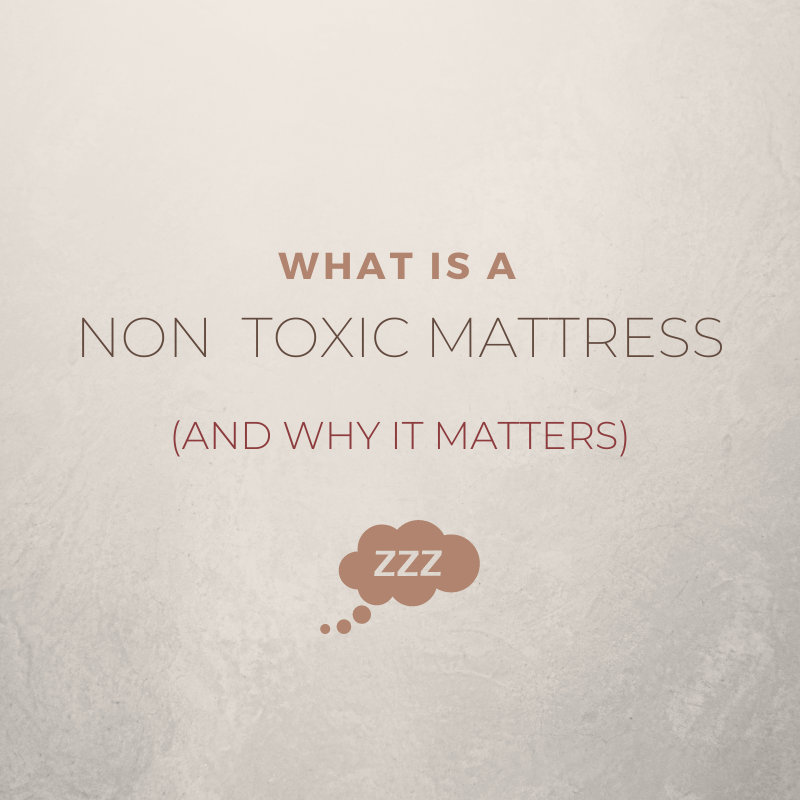Mattresses - does it really matter what we're sleeping on?
The average newborn spends more than 70% of their day/night cycle asleep (ideally! *pass the coffee*). That's roughly 17 hours. By toddlerhood this peters out to 14 hours and while some pre-school age little humans only need 10 hours overnight, it's still very normal to be hitting the 13 hour nightly sleep mark.
Quick math, that's more than half of their daily cycle spent asleep, on top of a mattress, or maybe on you if you are still soaking up those sleeping baby cuddles. When in bed though, if they're anything like our kid and you are anything like us, they are face down on a mattress you know nothing about.
Choosing a mattress was a bit of a rabbit hole for us and in some ways I wish I didn't find out what really goes into mattress production as yes, it sure has been an expensive and time consuming endeavour changing our sleep environment to something more natural and non toxic. But I was told once there are three things that you should spend money on in your life and they are the things that connect us to the ground; shoes, beds and car tyres!
That being said, it would be an impossible feat to try and rid your whole environment/home from toxins, but where we can it is something that we try to minimise.
We just want to acknowledge that the 'eco conscious mental load' is a real thing and it is important to decide what and where you want to prioritise your limited bandwidth. We all try to do the very best for our kids and honestly, we would burn out completely if we took on board absolutely every eco article so maybe save this blog for another time if you don't have the capacity at the moment.
This is your permission to exit out of this article and go shopping for some cool toys instead.
We would also like to note that we are by no means experts in this topic and you should do your own research.
Do you know what is in your mattress?
Not so fun fact: There really isn't very much regulation in the Australian (or worldwide) mattress industry when it comes to what materials and chemicals are allowed to be used.
Here's some common 'ingredients' in your everyday mattresses...
FLAME RETARDENTS
They kinda sound like a good thing right? Like, yes they may stop materials being flammable but they are also linked to a whole heap of nasty health effects from being carcinogenic or endocrine disrupting to being associated with lower IQ, poor attention and motor coordination. Check out this study for more info on this.
PHTHALATES
These guys are endocrine disrupting chemicals (EDCs) and linked strongly to asthma, low testerone, undescended testes and poor sperm quality as well as a heap of other negative health effects. Phthalates are found in the PVC waterproofing covers of mattresses (particularly cot and bassinet mattresses). Here is a study by the World Health Organisation that explains more.
The chemicals/toxins mentioned above are just to name a few. The Australian mattress industry isn't obliged to provide an ingredient list so even those mattresses marketed as 'natural' might not be. Gotta love green-washing.
Another place to read about this in more detail is My Non Toxic Tribe's article on Choosing A Non Toxic Mattress.
What is the alternative?
After realising that all our mattresses are chem-pits we set out to find a more natural alternative. This was indeed going to be an expensive exercise and not something that we did all at once.
After a lot of research we found out that 100% natural latex is the only material of the foams that doesn't release VOCs (volatile organic compounds).
Latex is also naturally mould and dust mite resistant.
There are a couple other natural mattress options such as wool or coconut fibre but from what we found latex seemed to be the best option in terms of affordability and lifespan.
It's definitely worth contacting any companies that advertise natural mattresses to ask for independent certifications - even materials labelled as 'organic' might not be. Look for the GOTS certification to be sure.
As a company that prides itself on making eco-conscious choices, we welcome questions about our own products because we know the answers. Any mattress company that wasn't as welcoming got the flick.
Why we chose Peacelily
Without writing an entire thesis on mattress differences, we'll just cut to our choice. Full disclosure, Peacelily have compensated us for sharing our mattress choice but we had already made up our minds to purchase from them. We have purchased from them before (a Queen and a Single for Lauren's house) and can confirm the mattresses are super comfortable.
We choose Peacelily mattresses for the following reasons:
- 100% natural organic latex (no springs) - therefore no VOCs or petrochemicals
- GOTS certified 100% organic cotton fabric and wadding
- To reiterate, no nasties
- Adjustable for 3 firmness settings
- 100 night free trial
- COST is LESS THAN than a normal bedding retailer mattress and not too much more than the cheaper 'bed in a box' options. They also come with a 25 year warranty (wow!) instead of the standard 10 years you'd get from your local bedding provider store.
Also, free shipping - winner, winner!
This was one of those times that choosing the Earth (and the quality of our respiration) was an easy option.
And a fun fact I learnt, because of the washing process that latex undergoes during the manufacturing process and the fact that your skin won't be directly exposed to the latex contained inside the mattress, most people with latex allergies will not be affected by sleeping on a latex mattress. In case you were wondering!








0 comments